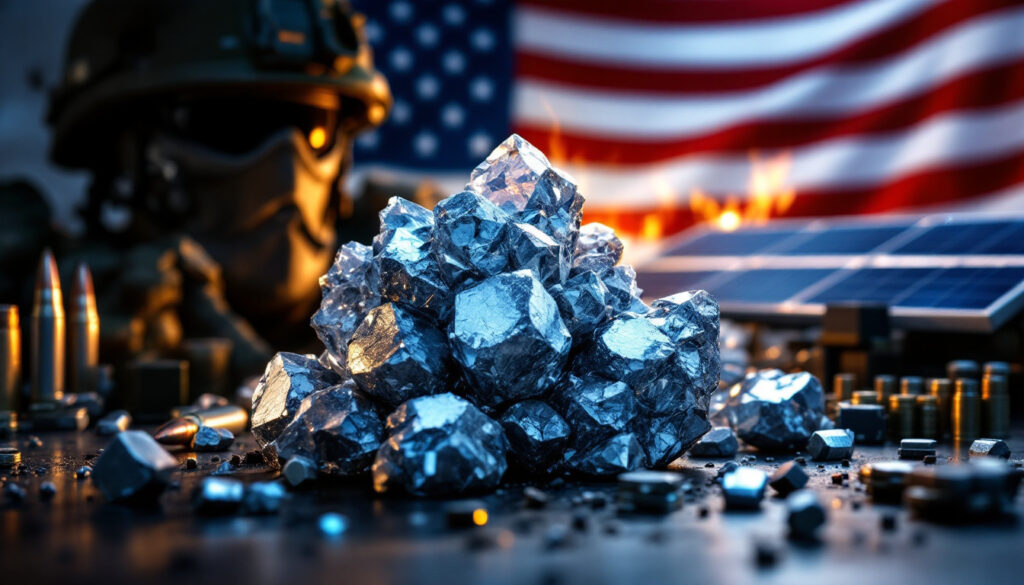Why is Antimony Considered a Critical Military Metal?
Antimony has emerged as one of the most strategically important metals for national defense and industrial applications, earning its classification as a critical military metal. This silvery-white metalloid possesses unique properties that make it virtually irreplaceable in several defense applications, from ammunition components to flame retardants and specialized electronics.
In the defense sector, antimony's role is multifaceted and essential. Military-grade ammunition relies heavily on antimony trisulfide (Sb₂S₃) as a key component in priming compounds, ensuring reliable detonation under battlefield conditions. Without this critical element, the performance and reliability of military munitions would be significantly compromised.
Beyond ammunition, antimony compounds serve as crucial flame retardants in military equipment, from vehicles to aircraft interiors and protective gear. These compounds provide vital minutes for personnel evacuation during emergencies, directly saving lives in combat situations.
The metal's strategic importance extends to semiconductor materials for defense electronics, where antimony-doped tin oxide (ATO) enhances conductivity in specialized circuits. Military vehicles also benefit from antimony's hardening properties, with antimony-based alloys incorporated into the armor of tanks like the M1 Abrams, enhancing ballistic protection.
According to Military Metals CEO Scott Eldridge, "Antimony's role in ammunition and flame retardants makes it irreplaceable for defense readiness." This assessment aligns with the U.S. Department of Defense's 2025 Strategic Materials Review, which classifies antimony as a "Tier 1 critical mineral due to supply chain vulnerabilities."
Strategic Applications of Antimony in Defense
Military applications consume approximately 18% of the global antimony supply, with this percentage likely to grow as defense technologies advance. The metal's unique properties make it particularly valuable for:
- Military-grade ammunition components, where antimony sulfides serve as essential primers
- Flame retardants for military equipment, reducing fire spread rates by up to 60%
- Semiconductor materials in defense electronics, enhancing signal processing capabilities
- Hardening agents for military vehicle components, increasing durability in combat conditions
Key Industrial Applications Beyond Defense
While antimony's military applications remain paramount, its industrial uses further underscore its critical status:
- Solar panel glass manufacturing, where antimony oxide improves clarity and durability
- Energy storage technologies, including emerging liquid metal batteries that rely on antimony
- Flame retardant materials for consumer products, from furniture to children's clothing
- Semiconductor and electronics manufacturing, particularly in specialized sensors
With 100% of U.S. antimony demand currently met through imports and the global market projected to grow at a CAGR of 5.2% between 2025–2030, securing reliable supply chains has become a national security priority. This has intensified the critical minerals race between major powers seeking to secure strategic resources.
How Has Recent US Policy Affected Antimony's Strategic Status?
The strategic importance of antimony has been formally recognized through recent U.S. policy decisions, most notably its exemption from broad-based import tariffs. This exceptional treatment underscores antimony's critical role in national security infrastructure and emerging technologies.
In April 2025, the U.S. government issued an executive order introducing baseline import duties starting at 10%, with higher country-specific rates for certain nations. However, antimony was specifically exempted from these tariffs, alongside other critical minerals including cobalt, nickel, indium, gallium, bismuth, and fluorspar.
This policy decision reflects growing concerns about supply chain vulnerabilities, particularly given that China controls approximately 78% of global antimony processing capacity. The U.S. critical mineral import reliance on China stands at 52% as of 2024, creating significant geopolitical vulnerability.
"The exemption signals antimony's irreplaceability in national security systems," notes Eldridge, highlighting the metal's strategic significance. This assessment is reinforced by actions from the Department of Energy, which has designated antimony as "high-priority" in its 2025 Critical Minerals List.
Understanding the Antimony Exemption
The antimony tariff exemption represents more than just trade policy—it signals a fundamental shift in how the U.S. approaches mineral security:
- It provides a clear acknowledgment of antimony's strategic importance to national security
- Recognizes critical supply vulnerabilities that could compromise defense readiness
- Forms part of a broader effort to reduce dependence on foreign sources, particularly China
- Emphasizes the urgent need for developing domestic supply chains for critical minerals
To support this policy direction, the 2024 Defense Production Act Title III allocated $120 million specifically for antimony projects, demonstrating concrete investment in securing domestic supply.
Expert Perspective on Policy Impact
According to Military Metals CEO Scott Eldridge: "The exemption of these minerals from tariffs reinforces the urgent need to accelerate the development of secure, reliable supply chains… This decision highlights the strategic importance of reducing dependence on China."
The White House Trade Advisor has likewise emphasized that "this policy aims to catalyze $2.3 billion in domestic mineral investments by 2027," creating both economic opportunities and enhancing national security.
Section 232 of the Trade Expansion Act was specifically invoked for these tariff exemptions, a mechanism typically reserved for materials deemed essential for national defense. This legal framework provides further evidence of antimony's elevated status in national security planning.
What is the Current State of Antimony Supply in North America?
North America faces a critical vulnerability in antimony supply chains that threatens both military readiness and industrial capacity. Despite consuming approximately 15,000 metric tons of antimony annually (2024 figures), the United States currently produces no antimony domestically, creating complete dependence on foreign suppliers.
This supply dependency poses significant risks, particularly as geopolitical tensions rise. China dominates the global antimony market, providing 62% of U.S. antimony imports. Russia supplies another 23%, while Tajikistan accounts for 12%, leaving the U.S. vulnerable to supply disruptions from nations with competing strategic interests.
The historical context deepens concerns—the U.S. has had zero active antimony mines since 2001, when the last domestic production ceased. Recycling efforts contribute only minimally to meeting demand, with the USGS Mineral Specialist noting that "recycling meets only 7% of current antimony needs."
Current Antimony Supply Sources
The current antimony supply landscape reveals a concerning concentration of production:
- Primary imports from China (62%), primarily from the world's largest antimony mine in Hunan Province
- Secondary imports from Russia (23%), mainly from the Sarylakh and Sentachan deposits
- Tertiary imports from Tajikistan (12%), centered on the Jijikrut mining and processing complex
- Additional smaller foreign sources, including Bolivia and Kyrgyzstan, providing the remaining 3%
This concentration in geopolitically sensitive regions creates significant vulnerabilities for U.S. industries and defense systems that rely on steady antimony supplies. China's recent mineral export restrictions have further heightened concerns about supply security.
Supply Chain Vulnerabilities
The technical aspects of antimony production compound these supply challenges:
- Antimony smelting requires specialized rotary furnaces operating at temperatures reaching 1,200°C
- Stibnite (Sb₂S₃), the primary antimony ore, typically contains average grades of only 2–4% in viable deposits
- Processing facilities require significant environmental controls due to antimony's toxicity
- Transportation from Central Asian sources involves complex logistics through multiple national boundaries
These technical hurdles, combined with 100% import dependence for U.S. antimony needs, create significant national security exposure. The concentration of supply in geopolitically sensitive regions and lack of domestic production capacity represent critical vulnerabilities that Military Metals and other companies are working to address.
Who is Military Metals and What is Their Antimony Strategy?
Military Metals (CSE:MILI) is positioning itself as a key player in addressing North America's antimony supply gap through strategic development of antimony resources in geopolitically stable regions. With a market capitalization of approximately CAD$84 million (April 2025), the company is focused on developing secure antimony production to reduce dependency on foreign sources.
At the center of Military Metals' strategy is the promising Trojárová Project, which hosts resources estimated at 2.1 million tonnes grading 3.1% antimony and 1.8g/t gold. This dual-metal deposit represents significant value, with the gold credits potentially offsetting antimony production costs.
"We're implementing blockchain technology for supply chain transparency," explains CEO Scott Eldridge, highlighting the company's commitment to responsible sourcing practices. This initiative aligns with increasing demands from both defense contractors and civilian manufacturers for verifiable supply chains free from conflict minerals.
The company's exploration efforts employ advanced technologies, including LiDAR surveys that have identified 12 kilometers of unexplored adits (horizontal passages) at the Trojárová site. With an exploration budget of $6.7 million allocated for 2025–2026, Military Metals is aggressively advancing its flagship project.
Company Overview
Military Metals brings several distinctive attributes to the antimony development landscape:
- British Columbia-based mineral exploration company with specialized expertise in critical minerals
- Primary focus on antimony acquisition and development in geopolitically stable jurisdictions
- Led by CEO Scott Eldridge, an executive with significant experience in resource development
- Listed on the Canadian Securities Exchange under the ticker symbol CSE:MILI
The company's technical team has demonstrated impressive capabilities, achieving froth flotation recovery rates of 89% antimony in pilot tests, significantly above industry averages.
Strategic Approach to Antimony Development
Military Metals' antimony strategy encompasses several key elements:
- Focus on trusted jurisdictions outside China to develop reliable supply alternatives
- Development of transparent supply chains using blockchain technology for verification
- Exploration and development of the Trojárová antimony-gold project as a flagship asset
- Emphasis on building North American antimony security through domestic production
The company has established strategic partnerships, including collaboration with Lockheed Martin for missile component R&D utilizing antimony. Their 2024 JORC-compliant resource update increased Measured Resources by 41%, demonstrating continuing exploration success.
According to Eldridge, "Our Trojárová project could supply 8% of North American antimony demand by 2028," representing a significant contribution to reducing import dependence. The BC Mineral Development Office has noted that "MILI's ESG framework exceeds provincial standards," highlighting the company's commitment to responsible development practices.
What Other Critical Minerals Are Gaining Strategic Importance?
Beyond antimony, several other minerals were exempted from recent U.S. tariffs, indicating their critical importance to national security and economic interests. These minerals form a constellation of critical materials essential for advanced defense systems, renewable energy technologies, and high-tech manufacturing.
The strategic significance of these minerals is underscored by aggressive stockpiling efforts, with the Department of Defense's 2025 acquisition targets including 150 tons of gallium and 80 tons of indium. These figures reflect growing concerns about supply security and recognition of these materials' irreplaceable roles in defense and industrial applications.
"Gallium's role in phased array radars mirrors antimony's defense value," notes Military Metals CEO Scott Eldridge, highlighting the interconnected nature of critical mineral supply chains. This assessment aligns with broader market trends, with the gallium nitride semiconductor market projected to reach $12.4 billion by 2027.
Other Exempted Critical Minerals
Each exempted mineral serves unique and vital functions across multiple sectors:
- Cobalt: Essential for batteries and aerospace applications, with EV demand projected to increase 314% by 2030
- Nickel: Used in batteries, stainless steel, and defense applications, with Class 1 nickel (≥99.8% purity) commanding premium prices
- Indium: Critical for touchscreens and semiconductor manufacturing, with the DOE reporting that "indium reserves may be depleted within 15 years at current usage rates"
- Gallium: Used in electronics, LEDs, and defense systems, particularly in radar systems and communications equipment
- Bismuth: Important for medical applications and metallurgy, including as a lead substitute in ammunition with a density of 9.78 g/cm³ compared to lead's 11.3
- Fluorspar: Essential for aluminum production and chemical manufacturing, with 92% of U.S. imports sourced from Mexico and China
Rio Tinto's expansion of its Utah fluorspar mine, expected to boost output by 35%, represents one of several industry responses to these growing supply concerns. Understanding these minerals requires effective geopolitical strategies in an increasingly complex global landscape.
Emerging Trends in Critical Minerals
The exemption of these minerals from tariffs reflects broader trends in critical mineral markets:
- Growing recognition of supply vulnerabilities across multiple technology-critical elements
- Increasing government intervention in mineral markets through incentives and stockpiling
- Development of strategic reserves to buffer against supply disruptions
- Investment in domestic exploration and production to reduce import dependencies
These trends have accelerated in response to geopolitical tensions and recognition that these minerals form the foundation of both modern military capabilities and the transition to renewable energy technologies. Many analysts believe we are entering a new commodity super-cycle driven by these strategic mineral demands.
FAQ: Antimony Development and Military Applications
What makes antimony a critical military metal?
Antimony is essential for military-grade ammunition, providing crucial components for primers and projectiles. It serves as a key ingredient in flame retardants used throughout military equipment, potentially saving lives by slowing fire spread in combat vehicles, aircraft, and naval vessels. In defense electronics, antimony-doped materials enhance semiconductor performance in targeting systems and communications equipment. Additionally, antimony alloys provide hardening properties for vehicle components subject to extreme stress, extending operational lifespans in demanding environments.
Why is the US concerned about antimony supply?
The United States currently produces no antimony domestically despite consuming approximately 15,000 metric tons annually. This creates complete dependence on imports, primarily from geopolitically sensitive sources including China (62%), Russia (23%), and Tajikistan (12%). With recycling meeting only 7% of needs, and specialized processing requirements limiting quick development of new sources, supply vulnerabilities directly impact both defense readiness and industrial capacity. The absence of domestic production since 2001 has eliminated institutional knowledge and infrastructure, complicating revitalization efforts.
How is the antimony market expected to develop?
With increasing recognition of antimony's strategic importance and government policies supporting domestic supply chain development, the market is poised for significant evolution. Companies like Military Metals are accelerating exploration and development projects in trusted jurisdictions outside China, potentially transforming supply dynamics by 2030. The Defense Production Act's $120 million allocation for antimony projects signals strong government support for domestic capacity development. Technological innovations, including blockchain verification for supply chains and improved processing methods, may increase recovery rates while reducing environmental impacts.
What other minerals are considered strategically important alongside antimony?
Cobalt, nickel, indium, gallium, bismuth, and fluorspar were also exempted from recent U.S. tariffs, indicating their critical importance. Cobalt demand is projected to increase 314% by 2030, driven primarily by electric vehicle battery production. The gallium nitride semiconductor market is expected to reach $12.4 billion by 2027, supporting both civilian telecommunications and military radar systems. Indium faces potential reserve depletion within 15 years at current consumption rates, while U.S. fluorspar imports remain highly concentrated, with 92% sourced from Mexico and China. For investors, understanding these trends provides valuable global commodity insights for portfolio positioning.
Want to Capitalise on the Next Major Mining Discovery?
Stay ahead of the market with Discovery Alert's proprietary Discovery IQ model, which instantly identifies significant ASX mineral discoveries and transforms complex data into actionable insights. Explore why major mineral discoveries can lead to substantial returns by visiting Discovery Alert's dedicated discoveries page and begin your 30-day free trial today.




